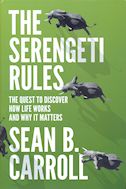Sean B. Carroll.
The Serengeti Rules
Princeton University Press. 2016
There is no actual “Balance of Nature”: everything is growing, changing, evolving, in flux.
Despite this, there is a kind of dynamic balance: our bodies maintain temperature,
animal population numbers don’t tend to grow exponentially or collapse, and so on.
These are dynamic balances, because they happen due to active processes.
Here Carroll explains how those processes have much in common from the molecular to the species level:
biological regulation is at play.
The logic of this evolved biological regulation is different from our engineered mechanical regulators:
rather than a positive logic of a process being switched on when needed,
it is often of a negative form: one process is constantly suppressing another,
and when that suppression is removed, the change occurs.
Carroll gives many examples.
Each chapter has a similar structure:
take one aspect of biology, and the scientists involved, and describe how they discovered the regulation logic.
We start at the beginning, with
Cannon’s discovery of the concept of homeostasis,
and Elton’s invention of ecology.
After these two introductory chapters, demonstrating analogous regulatory processes on vastly different scales,
we get several chapters on molecular level: lactose regulation, statins and cholesterol, and cancer.
Some of these have a “double negative” pattern of regulation –
X represses Y which represses Z, hence removing X increases Y, which then decreases Z –
so a change in one place can have a corresponding change elsewhere,
which will be unexpected unless the system is understood.
Next there are chapters about animal population regulation, keystone species, and trophic cascades:
it’s not just upward regulation by food abundance; there’s critical downward regulation by predators.
The book finishes with some positive examples about how, once we understand these negative regulatory patterns,
we can potentially reverse certain ecological collapses.
We need to identify the relevant keystone species:
wolves predate on elk, thereby allowing vegetation to survive to support other species;
bass eat minnows, reducing predation on the plankton that eat algae, which would otherwise cause blooms.
Knowing the system’s structure, we can potentially reintroduce, or at least stop destruction of,
the relevant species, to allow the ecosystem to move a healthier state.
This is a good account of a biological process that works over many orders of magnitude in scale.
Understanding how biological regulatory processes are negative,
rather than the more familiar engineered positive ones,
explains many otherwise counter-intuitive effects.
And understanding the web of interacting regulatory processes allows us to intervene in an effective manner,
allowing us to work with, rather than fight against, the system.
For all my book reviews, see
my main website.

No comments:
Post a Comment